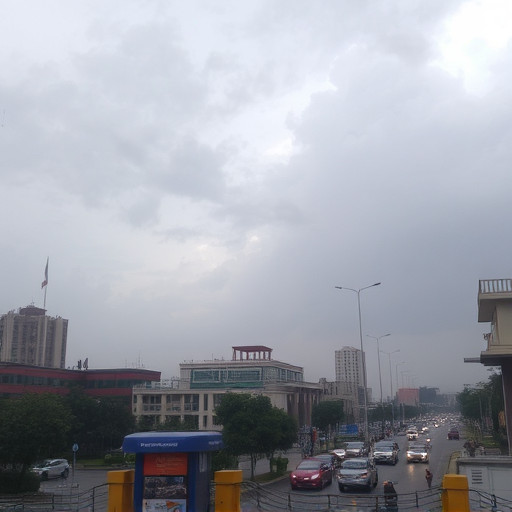
Karachi's complex climate, influenced by its coastal and hilly geography, requires advanced weather forecasting to navigate extreme weather events like heatwaves and heavy rains. Meteorological agencies employ a combination of satellite data, ground measurements, and predictive algorithms to issue forecasts, which are constantly improved through evaluation against actual weather conditions. To enhance accuracy, efforts focus on technological advancements and refined data analysis. Local models fine-tune predictions for immediate weather changes, while global models provide broader forecasts considering large-scale atmospheric phenomena. Integrating both types of models is crucial for reliable and accurate weather predictions in Karachi, supporting the city's preparedness and response to its climate-related challenges.
Exploring the nuances of weather forecasting in Karachi, this article delves into the intricacies that influence meteorological predictions. We examine the reliability of weather predictions for this coastal city, contrasting local with global models to uncover which offers the most accurate prognostications. Understanding the factors that impact Karachi’s climatic forecasts is crucial for preparedness and planning, especially given the city’s vulnerability to extreme weather events. Join us as we navigate the complexities of predicting Pakistan’s economic hub’s weather patterns, ensuring a comprehensive analysis of the models at play.
- Assessing Karachi's Weather Prediction Reliability
- Factors Influencing Karachi's Climatic Forecasts
- Evaluating Local vs. Global Weather Forecast Models for Karachi
Assessing Karachi's Weather Prediction Reliability

Karachi, situated on the Arabian Sea in Pakistan, experiences a tropical climate with distinct monsoon and dry seasons. Assessing the reliability of weather forecasts for Karachi is critical due to its susceptibility to extreme weather events such as intense heatwaves and heavy rainfall during the monsoon season. The accuracy of these forecasts can significantly impact the safety and well-being of its residents, as well as infrastructure preparedness.
Several factors contribute to the variability in weather prediction accuracy for Karachi. These include the complex topography of the region, the influence of the sea on local weather patterns, and the dynamic nature of climate systems. Meteorological services employ a combination of satellite data, ground-based observations, and predictive models to forecast weather conditions. The effectiveness of these forecasts is often gauged by comparing them with actual weather outcomes over time. Continuous improvements in meteorological technologies and data analysis methods aim to enhance the precision of weather predictions for Karachi, thereby aiding in better preparedness and response strategies for its population and infrastructure.
Factors Influencing Karachi's Climatic Forecasts

Karachi, situated on the Arabian Sea coast in Pakistan, experiences a tropical climate with distinct monsoon and dry seasons. The accuracy of weather forecasts for this city is influenced by several factors, both regional and global. Locally, factors such as the topography of the area, including the coastal plains and nearby hills, play a significant role in how atmospheric conditions manifest in Karachi’s microclimate. These geographical features can affect temperature gradients, wind patterns, and humidity levels, which in turn impact weather prediction models.
On a broader scale, the accuracy of forecasts is also influenced by larger-scale climatic phenomena such as the El Niño–Southern Oscillation (ENSO), the Indian Ocean Dipole (IOD), and the monsoon trough. These large-scale systems can significantly alter weather patterns over South Asia, including the Sindh province where Karachi is located. Additionally, the availability and quality of meteorological data, the calibration and resolution of weather models, and the expertise of forecasters are crucial to providing reliable forecasts. The use of satellite imagery, radar technology, and ground-based observations further enhances the predictive capabilities, yet the complexity of regional weather patterns means that forecasts for Karachi must be continually refined and updated to improve their accuracy.
Evaluating Local vs. Global Weather Forecast Models for Karachi

In assessing the most accurate weather forecasts for Karachi, it is crucial to compare local and global weather forecast models. Local models are tailored to capture the nuances of the region’s unique climatic conditions, taking into account topographical features and local climate patterns that may influence weather predictions. These models often utilize high-resolution data from nearby weather stations, which can provide more precise forecasts for short-term weather events such as rainfall or thunderstorms. On the other hand, global models offer broader coverage and are informed by a vast network of observations across the planet. They are particularly effective for long-range forecasting due to their comprehensive data inputs and sophisticated algorithms that account for large-scale atmospheric phenomena, like monsoons or ocean currents affecting the region.
The accuracy of weather forecasts can be influenced by several factors, including the model’s resolution, the quality of initial conditions, and the sophistication of its underlying equations. For Karachi, a coastal city in Pakistan, both local and global models play a role in providing comprehensive weather predictions. Local models are adept at predicting day-to-day weather changes, which can be critical for residents and businesses in the city. Conversely, global models offer a broader context for understanding how regional weather patterns might evolve over time, providing valuable insights that complement the local forecasts. For the most accurate weather predictions, a combination of both approaches is often employed, leveraging the strengths of each to improve overall forecast reliability and inform decision-making processes in Karachi.
In examining the reliability of weather forecasts for Karachi, it is clear that while no model is infallible, local weather forecast models tend to outperform global counterparts due to their finer scale and ability to account for specific regional factors. This analysis underscores the importance of continuous improvement in meteorological practices and technology to enhance predictive accuracy for cities like Karachi, where weather patterns can have significant impacts on the daily lives of its residents. As such, stakeholders should invest in refining local weather forecasting methods to provide the most accurate predictions possible, ensuring better preparedness for extreme conditions and optimizing decision-making processes in various sectors.


